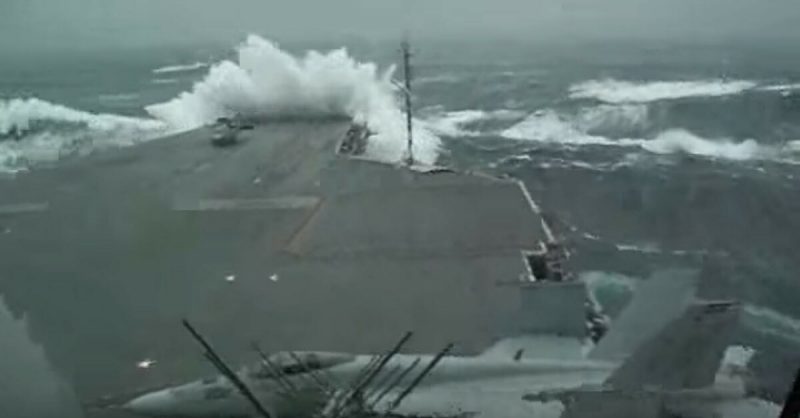Ever since the Aircraft Carrier replaced the battleship as the queen of the sea, it has defined what modern sea power is all about.
However, every now and then mother nature shows what she is capable off, throwing waves over the flight deck.
The dimensions of this super-carrier are mind-boggling to begin with; 1068 feet long, 257 feet wide and displacing over 97 thousand long tons.
It stands just over 244 feet from the keel to the mast which is about the height of a 24-story building. The anchors alone weigh 66,140 lb!
The ship can reach speeds of over 30 knots and is powered by four Westinghouse geared steam turbines, eight Foster Wheeler steam boilers that turn 4 five-bladed screws of 66,220 pounds each.
Between 5,500 and 6,200 crew members are required to operate it which require all the facilities of a floating city.
Aircraft carriers and the technology associated with them have come a long way since their origins during the First World War. Modern super-carriers have their roots in the early years of the 20th Century, when in 1910 a pilot named Eugene Burton Ely made history by taking off in his plane from the deck of ship.
Nations around the world were soon experimenting with this concept. Even before hostilities broke out, it was obvious to many that a war was coming.
With this in mind, many countries began trying to invent and develop new military technology that might give them an advantage once open warfare actually began.
Self-loading pistols, tanks and submarines all came out of the ensuing arms-race and the military conflict to which it was leading.
However, one particularly innovative and impactful new field was that of aerial combat. Zeppelins, warplanes and other aircraft were built and put to use, and as a natural result of this, new ways to launch and transport these machines had to be developed.
The year 1918 saw the appearance of the first flattop ship with the capacity to launch and recover a naval aircraft; HMS Argus.
Although these vessels offered some incredible tactical advantages to any country who possessed them, the Washington Naval Treaty restricted the construction of new combat ships. This meant that fewer aircraft carriers could be built entirely from scratch.
Instead, many navies began reworking ships that had already been built for different purposes. Everything from cargo ships to battle cruisers were converted, and aircraft carriers quickly became an essential part of naval forces around the globe.
Only 21 years after the end of the First World War, conflict gripped the world once again, as the Allies and Axis powers found themselves locked in the deadliest war in human history.
By this point, airplanes and aerial battles were even more essential as the key to victory.
Consequently, aircraft carriers were proving their worth like never before.
Then, on the 7th of December 1941, the Japanese demonstrated the true power and effectiveness of these enormous ships.
Launching an unprecedented attack on the United States, they bombed Pearl Harbor with more than 400 aircraft, backed up by multiple naval vessels.
Although submarines and battleships were an integral part of their strategy, it was the large number of aircraft carriers concentrated into a single fleet that allowed them carry out such a huge assault.
After Pearl Harbor, there could be no doubt that these behemoths were needed by navies and air forces across the world.
Over the ensuing decades, bigger and more technologically advanced aircraft carriers were constructed and put into action on the sea. Today, 37 of these incredible vessels are active, in twelve navies.
In this video, the USS Kitty Hawk is plowing through heavy seas with waves so massive, they even go across the flight deck and hit the bridge. At the flight deck a black hawk helicopter and an F-18 Hornet have been left, securely chained down.
Campaign to Save Doomed Falklands War Carrier From the Scrapyard
It’s a striking reminder, however, that even that largest and more impressive ships face incredible dangers from the ocean itself.
